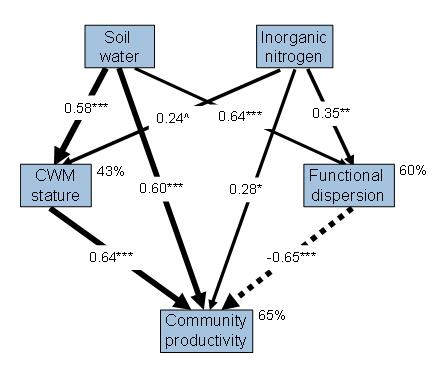Ongoing global environmental variations have triggered productive research aiming to explore the changes in ecosystem functions.
While these efforts have proven fruitful, the mechanistic pathways behind the observed changes remain poorly understood.
Cooperating with Prof. Lin Jiang from Georgia Institute of Technology, Dr. XU Zhuwen and her colleagues from Soil Chemistry research group in Institute of Applied Ecology, CAS explored the relative importance of direct and indirect environmental change effects on plant primary productivity based on a long-term experiment that increased growing season precipitation and nitrogen deposition in a temperate steppe.
They showed that increases in water and nitrogen availability influenced plant productivity via both direct and indirect pathways.
While both treatments stimulated plant productivity, changes in plant productivity could not be explained by observed changes in species or phylogenetic diversity.
Instead, the indirect effects of water and nitrogen addition were through their positive effects on plant functional diversity.
Importantly, while the increase in one component of functional diversity (community-level weighted mean of plant stature) resulted in increased productivity, the increase in another component of functional diversity (functional dispersion) resulted in decreased productivity.
This study provides the first evidence for the opposite effects of community-weighted means and functional dispersion of plant functional traits on grassland productivity and highlights the importance of both traits of dominant species and trait distribution among species in modulating the effects of global changes on ecosystem functions.
This research has been published in Journal of Ecology entitled as “Plant functional diversity modulates global environmental change effects on grassland productivity”.
This work was financially supported by grants from the National Natural Science Foundation of China, the National Key Research and Development Program of China and the National Science Foundation of USA.

Fig. 1 Boxplot showing the differences in plant community productivity amongnitrogen and water treatments. C: control, N: nitrogen addition, W: water addition, WN: water plus nitrogen addition (Image by XU Zhuwen).

Fig. 2 The final structural equation model relating soil water, inorganic nitrogen concentration, CWM of plant stature and functional dispersion to plant community productivity (Image by XU Zhuwen).
Email: yueqian@iae.ac.cn
Publication Name: XU Zhuwen et al.